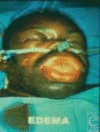Smoke inhalation lung injury: an update
- PMID: 18552974
- PMCID: PMC2396464
Smoke inhalation lung injury: an update
Abstract
Objectives: The purpose of this study is to present a multifaceted, definitive review of the past and current status of smoke inhalation injury. History along with current understanding of anatomical, physiology, and biologic components will be discussed.
Methods: The literature has been reviewed from the early onset of the concept of smoke inhalation in the 1920s to our current understanding as of 2007.
Results: The results indicate that the current pathophysiologic concept is of a disease process that leads to immediate and delayed pulmonary injury best managed by aggressive physiologic support. Management approaches for the biochemical changes have not kept up with current knowledge. The lung injury process is activated by toxins in the smoke's gas and particle components and perpetuated by a resulting lung inflammation. This inflammatory process becomes self-perpetuating through the activation of a large number of inflammatory cascades. In addition, smoke injury leads to significant systemic abnormalities injuring other organs and accentuating the burn injury process and subsequently leading to mediator-induced cellular injury leading potentially to multisystem organ failure.
Conclusions: Smoke inhalation injury results in the anatomic finding of denuded and sometimes sloughed airways mucosa. Physiologic findings include small airways containing fibrin casts of mucosa and neutrophils. Airway hyper-reactivity results as well, leading to further decreased collapse, causing obstruction.
Figures











Similar articles
-
Airway obstruction in sheep with burn and smoke inhalation injuries.Am J Respir Cell Mol Biol. 2003 Sep;29(3 Pt 1):295-302. doi: 10.1165/rcmb.4860. Am J Respir Cell Mol Biol. 2003. PMID: 12936906
-
Relationship of burn-induced lung lipid peroxidation on the degree of injury after smoke inhalation and a body burn.Crit Care Med. 1993 Dec;21(12):1935-43. doi: 10.1097/00003246-199312000-00023. Crit Care Med. 1993. PMID: 8252901
-
A rat model of smoke inhalation injury.Inhal Toxicol. 2012 May;24(6):356-64. doi: 10.3109/08958378.2012.673179. Epub 2012 Apr 24. Inhal Toxicol. 2012. PMID: 22530868
-
Management of acute smoke inhalation injury.Crit Care Resusc. 2010 Mar;12(1):53-61. Crit Care Resusc. 2010. PMID: 20196715 Review.
-
Oxidants and the pathophysiology of burn and smoke inhalation injury.Free Radic Biol Med. 1992;12(5):409-15. doi: 10.1016/0891-5849(92)90090-4. Free Radic Biol Med. 1992. PMID: 1592275 Review.
Cited by
-
Inhalation Injury in the Burned Patient.Ann Plast Surg. 2018 Mar;80(3 Suppl 2):S98-S105. doi: 10.1097/SAP.0000000000001377. Ann Plast Surg. 2018. PMID: 29461292 Free PMC article. Review.
-
Pathophysiology, research challenges, and clinical management of smoke inhalation injury.Lancet. 2016 Oct 1;388(10052):1437-1446. doi: 10.1016/S0140-6736(16)31458-1. Lancet. 2016. PMID: 27707500 Free PMC article. Review.
-
Quantitative proteome and lysine succinylome characterization of zinc chloride smoke-induced lung injury in mice.Heliyon. 2024 Mar 8;10(6):e27450. doi: 10.1016/j.heliyon.2024.e27450. eCollection 2024 Mar 30. Heliyon. 2024. PMID: 38524532 Free PMC article.
-
Dynamic Tracking Human Mesenchymal Stem Cells Tropism following Smoke Inhalation Injury in NOD/SCID Mice.Stem Cells Int. 2016;2016:1691856. doi: 10.1155/2016/1691856. Epub 2016 Sep 20. Stem Cells Int. 2016. PMID: 27725837 Free PMC article.
-
Preclinical and clinical studies of smoke-inhalation-induced acute lung injury: update on both pathogenesis and innovative therapy.Ther Adv Respir Dis. 2019 Jan-Dec;13:1753466619847901. doi: 10.1177/1753466619847901. Ther Adv Respir Dis. 2019. PMID: 31068086 Free PMC article. Review.
References
-
- Traber D, Pollard V. Pathophysiology of Inhalation Injury. In: Herndon D, editor. Total Burn Care. Philadelphia Pa: Saunders; 2002. 175 pp.
-
- Sachor F, Amllory G. Lung lesions in patients dying of burns. Arch Pathol. 1963;75:303–8. - PubMed
-
- Thompson P, Herndon D, et al. Effect on mortality of inhalation injury. Trauma. 1986;26:163–5. - PubMed
-
- Winternatz MC. Pathology of War Gas Poisoning. Princeton, NJ: Yale University Press; 1920.
LinkOut - more resources
Full Text Sources
Miscellaneous
